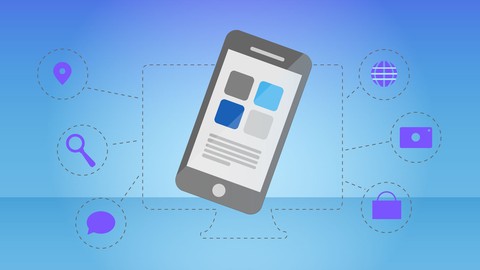
Progressive Web Apps (PWA) – The Complete Guide
Progressive Web Apps (PWA) – The Complete Guide, available at $109.99, has an average rating of 4.62, with 212 lectures, 1 quizzes, based on 11143 reviews, and has 65863 subscribers.
You will learn about Build web apps that look and feel like native mobile apps for iOS and Android Use service workers to build web apps that work without internet connection (offline-first) Leverage device features like the camera and geolocation in your web apps Use web push notifications to increase user engagement with your web apps This course is ideal for individuals who are Students who want to build web apps that look and behave like native mobile apps or Students who want to build offline-ready web apps (yes, that works!) or Anyone who wants to build web apps that offer access to the device camera, geolocation, push notifications and provide offline support or Students who want to leverage latest browser features whilst still supporting older browsers It is particularly useful for Students who want to build web apps that look and behave like native mobile apps or Students who want to build offline-ready web apps (yes, that works!) or Anyone who wants to build web apps that offer access to the device camera, geolocation, push notifications and provide offline support or Students who want to leverage latest browser features whilst still supporting older browsers.
Enroll now: Progressive Web Apps (PWA) – The Complete Guide
Summary
Title: Progressive Web Apps (PWA) – The Complete Guide
Price: $109.99
Average Rating: 4.62
Number of Lectures: 212
Number of Quizzes: 1
Number of Published Lectures: 208
Number of Published Quizzes: 1
Number of Curriculum Items: 216
Number of Published Curriculum Objects: 212
Original Price: $129.99
Quality Status: approved
Status: Live
What You Will Learn
- Build web apps that look and feel like native mobile apps for iOS and Android
- Use service workers to build web apps that work without internet connection (offline-first)
- Leverage device features like the camera and geolocation in your web apps
- Use web push notifications to increase user engagement with your web apps
Who Should Attend
- Students who want to build web apps that look and behave like native mobile apps
- Students who want to build offline-ready web apps (yes, that works!)
- Anyone who wants to build web apps that offer access to the device camera, geolocation, push notifications and provide offline support
- Students who want to leverage latest browser features whilst still supporting older browsers
Target Audiences
- Students who want to build web apps that look and behave like native mobile apps
- Students who want to build offline-ready web apps (yes, that works!)
- Anyone who wants to build web apps that offer access to the device camera, geolocation, push notifications and provide offline support
- Students who want to leverage latest browser features whilst still supporting older browsers
Progressive Web Apps (PWAs) bring mobile-app-like experiences to your users without requiring them to install an app from the app store/ play store.
You still create a web application (HTML, CSS, JavaScript) but this course will teach you how to add features such as camera access, service workers for offline support, push notifications and more. This combines the best of both worlds: You deliver fast, engaging and reliable experiences whilst still having the reach and accessibility of a web page.
“Progressive Web App” simply is a term summarizing all the features allowing you to deliver mobile-like experiences. The topic is highly trending and it also is a topic which is here to stay! Not only is it strongly promoted by Google, it’s also quickly being adopted by big companies like Twitter or the Washington Post.
Having the skills to build and optimize these kind of web apps is already an important and highly demanded skill for modern web developers, a trend which is only going to accelerate! Therefore, learning how to build PWAs will give you a competitive edge!
In detail, this course will cover everything you needto build amazing PWAs – leading to a score of 100 (out of 100) in Google’s PWA auditing tool “Lighthouse”:
-
Detailed explanationabout what a PWA exactly is
-
How to use an app manifest to make your web app installable on device homescreens
-
Using service workers to offer offlinesupport by caching assets
-
Advanced service worker usage and caching strategies
-
A refresher on Promises and the Fetch APIas both concepts are heavily used in PWAs
-
How to improve user engagement by adding push notifications
-
A way to synchronize data in the background, even if connection is lost
-
How to access native device features like the cameraor geolocation
-
Using Workboxto make service worker management easier
-
Explanations on how to turn your next SPA project into a PWA
-
And more
All these things are of course put into practice by building a course project. To ensure that you can apply the knowledge to ANY of your projects, the course project doesn’t assume any JavaScript framework but focuses on the core features mentioned above!
So this course has a lot to offer, how do you tell if it’s for you though?
It definitely is the right choice if
-
you already are a web developer (no matter if experienced or still new to the business) and want to prepare for the future
-
you enjoy working with HTML, CSS and JavaScript and want to leverage the full power the web and browser technologies have to offer
-
you want to deliver the best possible experiences to your users, using technologies like web push notifications or offline support
What do you need to know to get the most out of the course?
-
You need to know at least the basics of HTML, CSS and JavaScript
-
No advanced knowledge of these technologies required though
-
You DON’T need to know any JavaScript framework like Angular or React – PWAs work with ANY JavaScript app, even if you don’t use a framework at all (actually, that’s what we’ll build in the course!)
I’d be very happy to welcome you on board of this course and start this journey together with you!
Max
Course Curriculum
Chapter 1: Getting Started
Lecture 1: About this Course
Lecture 2: What are Progressive Web Apps?
Lecture 3: Join our Online Learning Community
Lecture 4: PWAs vs Native Mobile Apps
Lecture 5: Node.js Download
Lecture 6: A Demo PWA & What We'll Build in this Course
Lecture 7: Our First Progressive Web App
Lecture 8: PWA Core Building Blocks
Lecture 9: Comparing PWAs and SPAs
Lecture 10: What is "Progressive Enhancement"?
Lecture 11: Course Outline
Lecture 12: Course Project Setup
Lecture 13: How to get the Most out of this Course
Chapter 2: Understanding the App Manifest
Lecture 1: Module Introduction
Lecture 2: Using an App Manifest to Make your App Installable
Lecture 3: Adding the Manifest
Lecture 4: Understanding App Manifest Properties
Lecture 5: Adding Properties to the App Manifest
Lecture 6: PWAs and Browser Support
Lecture 7: Using the Chrome Developer Tools
Lecture 8: Simulating the Web App on an Emulator
Lecture 9: Preparing the Emulated Device for ALL PWA Features
Lecture 10: Installing the Web App – Prerequisites
Lecture 11: Adding Properties for Safari
Lecture 12: Adding Properties for the Internet Explorer
Lecture 13: Wrap Up
Lecture 14: Useful Resources & Links
Chapter 3: The Service Workers
Lecture 1: Module Introduction
Lecture 2: Why Service Workers Are Amazing!
Lecture 3: Understanding Service Worker Events
Lecture 4: The Service Worker Lifecycle
Lecture 5: Service Worker Browser Support
Lecture 6: Registering a Service Worker
Lecture 7: Reacting to Incoming Events (in SW)
Lecture 8: Updating & Activating Service Workers
Lecture 9: Non-Lifecycle Events
Lecture 10: The App Install Banner & Chrome 68+
Lecture 11: Getting that "App Install Banner"
Lecture 12: Connecting Chrome Developer Tools to a Real/ Emulated Device
Lecture 13: Testing the App on Real Device (and Installing the App!)
Lecture 14: Deferring the App Install Banner
Lecture 15: Wrap Up
Lecture 16: Service Worker FAQ
Lecture 17: Useful Resources & Links
Chapter 4: Promise and Fetch
Lecture 1: Module Introduction
Lecture 2: Async Code in JavaScript
Lecture 3: Promises – Basics
Lecture 4: Rejecting Promises
Lecture 5: Where we Use Promises in our Project
Lecture 6: Fetch – Basics
Lecture 7: Sending Post Requests via Fetch
Lecture 8: Fetch and CORS
Lecture 9: Comparing Fetch and Ajax
Lecture 10: Adding Polyfills (for Legacy Browser Support)
Lecture 11: Fetch & Service Workers
Lecture 12: [OPTIONAL] Assignment Solution
Lecture 13: Wrap Up
Lecture 14: Useful Resources & Links
Chapter 5: Service Workers – Caching
Lecture 1: Module Introduction
Lecture 2: Why Caching?
Lecture 3: Understanding the Cache API
Lecture 4: Browser Support
Lecture 5: Adjusting the Course Project
Lecture 6: Identifying (Pre-)Cacheable Items
Lecture 7: Static Caching/ Precaching
Lecture 8: Retrieving Items from the Cache
Lecture 9: Adding & Retrieving Multiple Files (to/ from Cache)
Lecture 10: Cache Multiple Files with addAll
Lecture 11: Dynamic Caching – The Basics
Lecture 12: Implementing Dynamic Caching
Lecture 13: Handling Errors
Lecture 14: Adding Cache Versioning
Lecture 15: Different Cache Versions & Cleanup
Lecture 16: Optimizing Cache Management
Lecture 17: [OPTIONAL] Assignment Solution
Lecture 18: Wrap Up
Lecture 19: Useful Resources & Links
Chapter 6: Service Workers – Advanced Caching
Lecture 1: Module Introduction
Lecture 2: Module Preparation: Adding a Button
Lecture 3: Offering "Cache on Demand"
Lecture 4: Providing an Offline Fallback Page
Lecture 5: Strategy: Cache with Network Fallback
Lecture 6: Strategy: Cache Only
Lecture 7: Strategy: Network Only
Lecture 8: Strategy: Network with Cache Fallback
Lecture 9: Strategy: Cache then Network
Lecture 10: Cache then Network & Dynamic Caching
Lecture 11: Cache then Network with Offline Support
Lecture 12: Cache Strategies & "Routing"
Lecture 13: Applying Cache Only
Instructors
-
Academind by Maximilian Schwarzmüller
Online Education -
Maximilian Schwarzmüller
AWS certified, Professional Web Developer and Instructor
Rating Distribution
- 1 stars: 36 votes
- 2 stars: 87 votes
- 3 stars: 503 votes
- 4 stars: 2959 votes
- 5 stars: 7558 votes
Frequently Asked Questions
How long do I have access to the course materials?
You can view and review the lecture materials indefinitely, like an on-demand channel.
Can I take my courses with me wherever I go?
Definitely! If you have an internet connection, courses on Udemy are available on any device at any time. If you don’t have an internet connection, some instructors also let their students download course lectures. That’s up to the instructor though, so make sure you get on their good side!
You may also like
- Best Video Editing Courses to Learn in February 2025
- Best Music Production Courses to Learn in February 2025
- Best Animation Courses to Learn in February 2025
- Best Digital Illustration Courses to Learn in February 2025
- Best Renewable Energy Courses to Learn in February 2025
- Best Sustainable Living Courses to Learn in February 2025
- Best Ethical AI Courses to Learn in February 2025
- Best Cybersecurity Fundamentals Courses to Learn in February 2025
- Best Smart Home Technology Courses to Learn in February 2025
- Best Holistic Health Courses to Learn in February 2025
- Best Nutrition And Diet Planning Courses to Learn in February 2025
- Best Yoga Instruction Courses to Learn in February 2025
- Best Stress Management Courses to Learn in February 2025
- Best Mindfulness Meditation Courses to Learn in February 2025
- Best Life Coaching Courses to Learn in February 2025
- Best Career Development Courses to Learn in February 2025
- Best Relationship Building Courses to Learn in February 2025
- Best Parenting Skills Courses to Learn in February 2025
- Best Home Improvement Courses to Learn in February 2025
- Best Gardening Courses to Learn in February 2025























